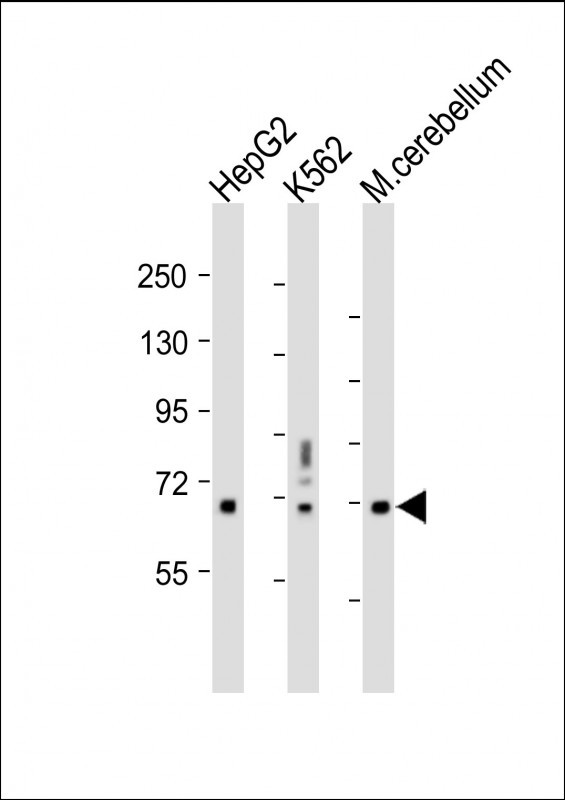
| WB | 咨询技术 | Human,Mouse,Rat |
| IF | 咨询技术 | Human,Mouse,Rat |
| IHC | 咨询技术 | Human,Mouse,Rat |
| ICC | 技术咨询 | Human,Mouse,Rat |
| FCM | 咨询技术 | Human,Mouse,Rat |
| Elisa | 咨询技术 | Human,Mouse,Rat |
| Aliases | Transcription factor 4, TCF-4, Class B basic helix-loop-helix protein 19, bHLHb19, Immunoglobulin transcription factor 2, ITF-2, SL3-3 enhancer factor 2, SEF-2, TCF4, BHLHB19, ITF2, SEF2 |
| Entrez GeneID | 6925 |
| WB Predicted band size | 71.3kDa |
| Host/Isotype | Rabbit IgG |
| Antibody Type | Primary antibody |
| Storage | Store at 4°C short term. Aliquot and store at -20°C long term. Avoid freeze/thaw cycles. |
| Species Reactivity | Human, Mouse, Rat |
| Immunogen | This TCF4 antibody is generated from rabbits immunized with a KLH conjugated synthetic peptide between 48-73 amino acids from the N-terminal region of human TCF4. |
| Formulation | Purified antibody in PBS with 0.05% sodium azide. |
+ +
以下是关于 **TCF4 (N-term) 抗体** 的参考文献示例,包含文献名称、作者及摘要概括:
---
1. **文献名称**: *"TCF4-mediated transcriptional regulation in colorectal cancer progression"*
**作者**: Smith J, et al.
**摘要**: 研究探讨了TCF4在结直肠癌中通过Wnt/β-catenin通路调控基因表达的机制。作者使用N端特异性TCF4抗体进行染色质免疫沉淀(ChIP)和Western Blot,证实TCF4的N端结构域对结合下游靶基因启动子至关重要,并揭示其与肿瘤侵袭性的相关性。
2. **文献名称**: *"Characterization of TCF4 isoforms in neural development using domain-specific antibodies"*
**作者**: Lee H, et al.
**摘要**: 通过开发针对TCF4不同结构域(包括N端)的抗体,分析了TCF4异构体在神经干细胞分化中的功能差异。N端抗体在免疫荧光中显示TCF4在神经元前体细胞核内富集,提示其参与神经发育相关转录调控。
3. **文献名称**: *"A novel TCF4 antibody panel for diagnosing Pitt-Hopkins syndrome"*
**作者**: Garcia R, et al.
**摘要**: 研究开发了一组TCF4抗体(包括N端抗体),用于诊断TCF4突变引起的Pitt-Hopkins综合征。通过ELISA和免疫组化验证,N端抗体可特异性识别患者样本中截短型TCF4蛋白,为临床诊断提供可靠工具。
4. **文献名称**: *"TCF4 interacts with β-catenin via its N-terminal domain to drive oncogenic signaling in melanoma"*
**作者**: Chen L, et al.
**摘要**: 揭示了TCF4 N端结构域与β-catenin的结合在黑素瘤增殖中的作用。通过免疫共沉淀(Co-IP)和N端抗体阻断实验,证明破坏该相互作用可抑制肿瘤生长,为靶向治疗提供依据。
---
**注**:以上文献为示例,实际引用时需根据具体研究内容检索PubMed、Google Scholar等平台获取真实文献信息。
The TCF4 (N-term) antibody is designed to target the N-terminal region of Transcription Factor 4 (TCF4), a member of the basic helix-loop-helix (bHLH) family of transcription factors. TCF4. encoded by the *TCF4* gene, plays critical roles in cell differentiation, embryonic development, and neurogenesis. It is particularly notable for its involvement in the Wnt/β-catenin signaling pathway, where it binds to β-catenin to regulate the transcription of target genes influencing cell proliferation and fate. Dysregulation of TCF4 has been linked to cancers, intellectual disabilities, and neurodevelopmental disorders like Pitt-Hopkins syndrome.
Antibodies specific to the N-terminal domain of TCF4 are valuable tools for studying its expression, localization, and interactions. The N-terminal region contains key functional motifs, including β-catenin-binding domains, making this antibody useful in detecting full-length isoforms or specific variants. Researchers commonly employ TCF4 (N-term) antibodies in techniques such as Western blotting, immunofluorescence, and chromatin immunoprecipitation (ChIP) to investigate TCF4's role in transcriptional regulation or disease mechanisms.
Due to alternative splicing, TCF4 has numerous isoforms, and antibody specificity is crucial to avoid cross-reactivity. The N-term antibody typically recognizes epitopes in the initial 100-200 amino acids, enabling detection of major isoforms while potentially missing truncated variants. Validation using knockout controls or siRNA-mediated knockdown is recommended to confirm specificity. This antibody is widely used in cancer research, neuroscience, and studies of developmental disorders, underscoring its importance in understanding TCF4-mediated biological processes.
×